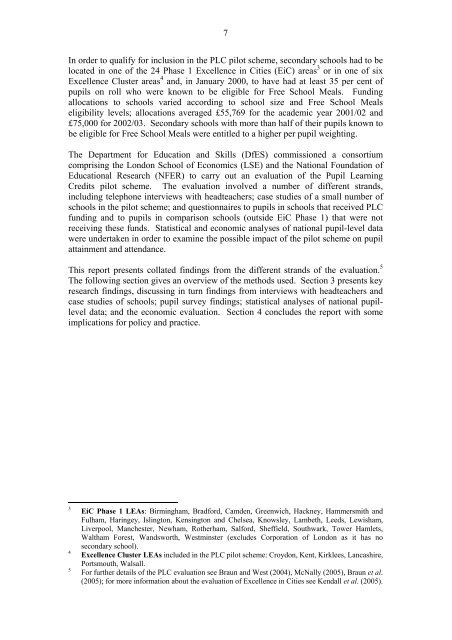Final Report of the Evaluation of the Pupil Learning Credits Pilot ...
Final Report of the Evaluation of the Pupil Learning Credits Pilot ...
Final Report of the Evaluation of the Pupil Learning Credits Pilot ...
Create successful ePaper yourself
Turn your PDF publications into a flip-book with our unique Google optimized e-Paper software.
7<br />
In order to qualify for inclusion in <strong>the</strong> PLC pilot scheme, secondary schools had to be<br />
located in one <strong>of</strong> <strong>the</strong> 24 Phase 1 Excellence in Cities (EiC) areas 3 or in one <strong>of</strong> six<br />
Excellence Cluster areas 4 and, in January 2000, to have had at least 35 per cent <strong>of</strong><br />
pupils on roll who were known to be eligible for Free School Meals. Funding<br />
allocations to schools varied according to school size and Free School Meals<br />
eligibility levels; allocations averaged £55,769 for <strong>the</strong> academic year 2001/02 and<br />
£75,000 for 2002/03. Secondary schools with more than half <strong>of</strong> <strong>the</strong>ir pupils known to<br />
be eligible for Free School Meals were entitled to a higher per pupil weighting.<br />
The Department for Education and Skills (DfES) commissioned a consortium<br />
comprising <strong>the</strong> London School <strong>of</strong> Economics (LSE) and <strong>the</strong> National Foundation <strong>of</strong><br />
Educational Research (NFER) to carry out an evaluation <strong>of</strong> <strong>the</strong> <strong>Pupil</strong> <strong>Learning</strong><br />
<strong>Credits</strong> pilot scheme. The evaluation involved a number <strong>of</strong> different strands,<br />
including telephone interviews with headteachers; case studies <strong>of</strong> a small number <strong>of</strong><br />
schools in <strong>the</strong> pilot scheme; and questionnaires to pupils in schools that received PLC<br />
funding and to pupils in comparison schools (outside EiC Phase 1) that were not<br />
receiving <strong>the</strong>se funds. Statistical and economic analyses <strong>of</strong> national pupil-level data<br />
were undertaken in order to examine <strong>the</strong> possible impact <strong>of</strong> <strong>the</strong> pilot scheme on pupil<br />
attainment and attendance.<br />
This report presents collated findings from <strong>the</strong> different strands <strong>of</strong> <strong>the</strong> evaluation. 5<br />
The following section gives an overview <strong>of</strong> <strong>the</strong> methods used. Section 3 presents key<br />
research findings, discussing in turn findings from interviews with headteachers and<br />
case studies <strong>of</strong> schools; pupil survey findings; statistical analyses <strong>of</strong> national pupillevel<br />
data; and <strong>the</strong> economic evaluation. Section 4 concludes <strong>the</strong> report with some<br />
implications for policy and practice.<br />
3<br />
4<br />
5<br />
EiC Phase 1 LEAs: Birmingham, Bradford, Camden, Greenwich, Hackney, Hammersmith and<br />
Fulham, Haringey, Islington, Kensington and Chelsea, Knowsley, Lambeth, Leeds, Lewisham,<br />
Liverpool, Manchester, Newham, Ro<strong>the</strong>rham, Salford, Sheffield, Southwark, Tower Hamlets,<br />
Waltham Forest, Wandsworth, Westminster (excludes Corporation <strong>of</strong> London as it has no<br />
secondary school).<br />
Excellence Cluster LEAs included in <strong>the</strong> PLC pilot scheme: Croydon, Kent, Kirklees, Lancashire,<br />
Portsmouth, Walsall.<br />
For fur<strong>the</strong>r details <strong>of</strong> <strong>the</strong> PLC evaluation see Braun and West (2004), McNally (2005), Braun et al.<br />
(2005); for more information about <strong>the</strong> evaluation <strong>of</strong> Excellence in Cities see Kendall et al. (2005).

















